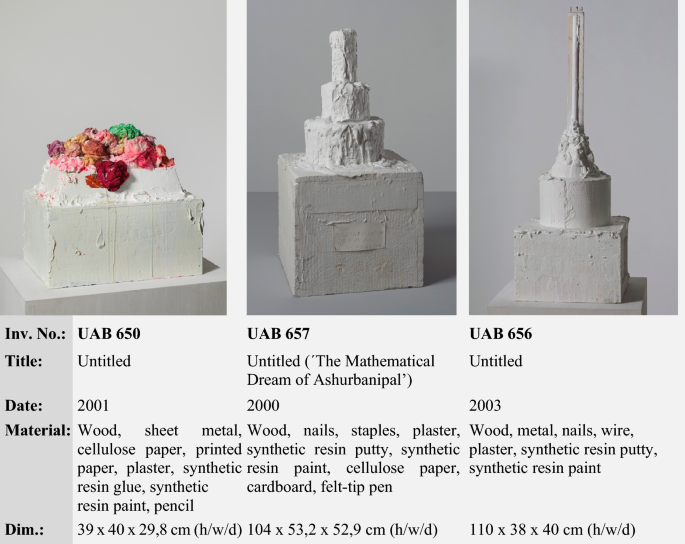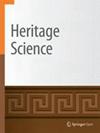Cy Twombly作品的x射线检查:“原始雕塑”的艺术技术和状态
IF 2.6
1区 艺术学
Q2 CHEMISTRY, ANALYTICAL
引用次数: 0
摘要
塞·托姆布雷的雕塑是用什么做的?本文概述了对美国艺术家Cy Twombly(1928-2011)的三个雕塑进行的无损检测,这是慕尼黑Doerner研究所艺术技术研究项目的一部分。这些艺术品是布兰霍斯特博物馆收藏的一部分,属于托姆布雷所谓的“原创雕塑”系列:艺术家用石膏和白色油漆覆盖和修饰的单个发现物品的组合。为了制定一个长期的保护策略,研究的重点是了解托姆布雷雕塑中使用的材料和施工方法。在与慕尼黑工业大学无损检测主席的合作下,这些艺术品使用x射线摄影和计算机断层扫描进行了检查。结果显示,Cy Twombly使用了由木材、塑料、金属和纸/纸板制成的各种日常用品来构建组合。出乎意料的是,检查显示,各个部分完全由石膏和油漆涂层连接在一起,没有额外的机械连接。因此,整体结构被证明是非常脆弱的,对物理应力非常敏感,无论是由于搬运、运输还是气候波动引起的微观结构应变。由于人们对塞·托姆布雷的材料选择和制作细节知之甚少,因此研究结果为了解这位20 / 21世纪最具影响力的艺术家之一的整体艺术过程和决策提供了宝贵的见解。保护人员可以利用艺术技术的发现来监测雕塑的状况,并制定或调整长期保护策略,包括环境气候条件、处理储存和运输规范等方面。此外,所产生的知识可以用于对具体材料的进一步研究,并转移到Cy Twombly的其他艺术品中。本文章由计算机程序翻译,如有差异,请以英文原文为准。

X-ray-based examination of artworks by Cy Twombly: art technology and condition of the ‘Original Sculptures’
Abstract What are Cy Twombly’s sculptures made of? This article presents an overview of a non-destructive examination conducted on three sculptures by American artist Cy Twombly (1928–2011) as part of an art-technological research project at the Doerner Institut in Munich. The artworks are part of the collection of the Brandhorst Museum and belong to Twombly’s series of so-called ‘Original Sculptures’: assemblages of individual found objects, which the artist covered and modified with layers of plaster and white paint. To develop a long-term preservation strategy, the research focused on understanding the materials and construction methods used in Twombly's sculptures. In collaboration with the Chair of Non-Destructive Testing at the Technical University of Munich, the artworks were inspected using X-ray radiography and computed tomography. The results showed that Cy Twombly used various everyday objects made from wood, plastics, metal, and paper/cardboard to build the assemblages. Unexpectedly, the examinations revealed that the individual parts are solely held together by the coating of plaster and paint, lacking additional mechanical connections. The overall structure thus proved to be very fragile and highly sensitive to physical stresses, whether due to handling, transport, or strains in the microstructure caused by climatic fluctuations. Since little was known about Cy Twombly´s choice of materials and manufacturing details, the results offer valuable insights into the overall artistic process and decision-making of one of the most influential artists of the 20th/twenty-first centuries. Conservators can use the art-technological findings to monitor the sculptures ‘condition and develop or adapt long-term preservation strategies, including aspects such as ambient climatic conditions and handling storage and transport specifications. In addition, the knowledge generated can be used for further research on the specific materials and transferred to other artworks by Cy Twombly.
求助全文
通过发布文献求助,成功后即可免费获取论文全文。
去求助
来源期刊

Heritage Science
Arts and Humanities-Conservation
CiteScore
4.00
自引率
20.00%
发文量
183
审稿时长
19 weeks
期刊介绍:
Heritage Science is an open access journal publishing original peer-reviewed research covering:
Understanding of the manufacturing processes, provenances, and environmental contexts of material types, objects, and buildings, of cultural significance including their historical significance.
Understanding and prediction of physico-chemical and biological degradation processes of cultural artefacts, including climate change, and predictive heritage studies.
Development and application of analytical and imaging methods or equipments for non-invasive, non-destructive or portable analysis of artwork and objects of cultural significance to identify component materials, degradation products and deterioration markers.
Development and application of invasive and destructive methods for understanding the provenance of objects of cultural significance.
Development and critical assessment of treatment materials and methods for artwork and objects of cultural significance.
Development and application of statistical methods and algorithms for data analysis to further understanding of culturally significant objects.
Publication of reference and corpus datasets as supplementary information to the statistical and analytical studies above.
Description of novel technologies that can assist in the understanding of cultural heritage.
 求助内容:
求助内容: 应助结果提醒方式:
应助结果提醒方式:


